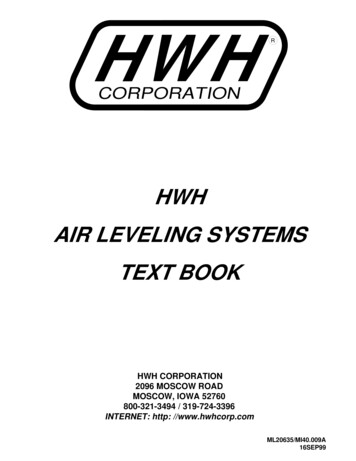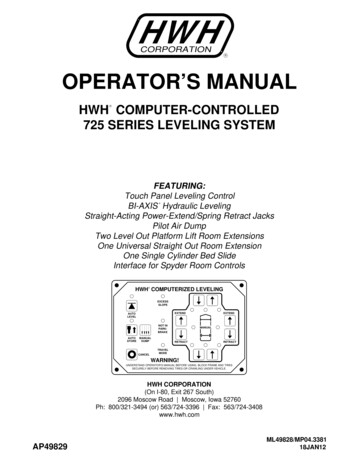
Transcription
HW HRCORPORATIONHWHAIR LEVELING SYSTEMSTEXT BOOKHWH CORPORATION2096 MOSCOW ROADMOSCOW, IOWA 52760800-321-3494 / 319-724-3396INTERNET: http: //www.hwhcorp.comML20635/MI40.009A16SEP99
HWH CORPORATIONMOSCOW, IOWA 52760HWH SYSTEMS TEXT BOOKAIR SUSPENSIONSHWH air leveling uses the vehicle’s air suspension to levelthe vehicle instead of using hydraulic cylinders. Air levelingcan only be used on vehicles with a full active airsuspension. A full active air suspension uses air springs(air bags) on the front and rear axles. These air bags arecontrolled by devices called "Height Control Valves"NOTE: Height Control Valves are sometimes referred toas "Leveling Valves". For the purpose of discussing theHWH air leveling system, we will refer to these as HeightControl Valves. These valves maintain a specific distancebetween the vehicle frame and axles. This distance isdetermined and set by the vehicle manufacturer. We callthis "Ride Height". The ride height is not controlled by theHWH leveling system.The height control valve is mounted to the frame of thevehicle and is attached to the axle through an "L" shapedlinkage. As the axle gets closer to the frame, the heightcontrol valve allows more air into the air bag(s). Thispushes the axle away from the frame to maintain the properride height. As the axle moves away from the frame, theheight control valve releases air from the air bag(s). Thisallows the axle to move closer to the frame to maintain theproper ride height.FROM AIRSUPPLYSome vehicles will be equipped with a tag axle. The tagaxle will normally have one air bag per wheel. Some tagaxles are simply tied into the drive axle. Most tag axles willbe independently controlled. Some will be controlled witha regulated air supply. Normally, Height Control Valves arenot used to control the tag axle. Some tag axles can havetheir air bags dumped separately from the other axles airbags. Some tag axles will have an air dump with a tag lift.AIR BAGSFRONT AXLEHEIGHTCONTROLVALVEHEIGHTCONTROLVALVESTYPICAL HEIGHTCONTROL VALVETO AIR BAG(S)DRIVE AXLEAIR BAGSAIR PRESSURE REGULATOREXHAUSTVEHICLEFRAMETAG AXLELINKAGEAIR BAGSAXLEThere can be different height control valve arrangements.There can be one valve for the front axle and two valves forthe rear. That can be reversed having two valves on thefront axle and one valve on the rear. There can also bedifferent air bag arrangements. There can be one or two airbags for each wheel. Sometimes, the front axle will bedifferent than the rear axle.All of these different situations must be considered whendesigning an air leveling system for a vehicle. The HWHair leveling system works in conjunction with the vehiclesuspension not only for leveling but also when the vehicleis in the travel mode.MI40.010A24SEP99
HWH CORPORATIONMOSCOW, IOWA 52760HWH SYSTEMS TEXT BOOKVEHICLE AIR SUPPLYMost vehicles with an air suspension also use an air brakesystem. These vehicles need a constant air supply.Normally the vehicle is equipped with an air compressorpowered by the vehicle’s engine. There will be a series oftanks to maintain the air supply. Although some vehicles,have different arrangements, they all have the same basicrequirements.There should be at least two air tanks. The primary functionof the air tanks is to supply air to the brake system of thevehicle. The suspension draws air from these tanks throughprotection valves. These valves protect the braking systemfrom loss of air due to engine failure or failures in the suspension system. If the air pressure in the tanks drop to a setpressure, usually between 60 and 70 psi, the protection valveswill not allow air into the suspension from the tanks. It is important not to disturb this protection system when adding anair leveling system to the vehicle.DASH AIR PRESSURE GAUGESNormally there is a pressure gauge for the primary and secondary tanks. Sometimes there will be an individual gaugefor each tank and sometimes there is one gauge with two indicators, one for each tank. Usually there will not be a gaugefor monitoring pressure available for the suspension. If theair pressure in the suspension drops to zero, the pressuregauges will still indicate the pressure maintained by the protection valves.There should also be an audible warning if the air pressurein the main system drops below 60 psi. The vehicle shouldnot be moved if a low air pressure warning indicator is on.How the HWH leveling equipment should connect to theexisting air system and suspension should be decided by thevehicle manufacturer.TO AIR TANKSECONDARYTANKCOMPPOP OFF VALVEAlthough it may vary between different vehicles, it normallytakes at least 60 psi to start lifting a vehicle. Most vehicleswill require 90 psi to obtain maximum lift. Some may requireup to 130 psi to obtain maximum lift.MI40.011A23SEP99
HWH CORPORATIONMOSCOW, IOWA 52760HWH SYSTEMS TEXT BOOKBASIC AIR LEVELINGRHWH provides (2) basic types of air leveling systems. Inone, HWH supplies a series of air solenoid manifolds tocontrol the air suspension for leveling. The other type ofleveling system is for Prevost busses. For the Prevost,HWH supplies only the electronics to control the Prevostair solenoid valves.As with hydraulics, BI-AXIS air leveling minimizes twistingof the vehicle. Air leveling is also accomplished easier andquicker when using combinations of air bags to raise andlower the vehicle. At this time, Prevosts can not be set upto do four-point BI-AXIS leveling.RAt this point, we will begin to discuss the air leveling systemsin detail. It is important to remember that the plumbing,wiring, and leveling programs may differ from one vehicleto another. The engineering departments of the vehiclemanufacturer and HWH should be involved when designinga new system.With either type of system, leveling is accomplished byisolating the air bags from the height control equipment. Airis then released from the air bags to lower the vehicle (or)air is added to the air bags to raise the vehicle.RAll present systems operate as a four-point, BI-AXIS systemwith the exception of the Prevost. HWH controls the sideair bags and the front or rear air bags of the vehicle to obtaina level position. Leveling the vehicle side to side shouldalways be done first before leveling the vehicle from front torear. Older air leveling systems and Prevosts use a threepoint air leveling system. The front air bags work as one toraise or lower the vehicle front to rear but the side to sideleveling is done with the rear air bags only.RBI-AXIS AIR LEVELINGRIGHT SIDEFRONTFRONTAIR BAGSREARAIR BAGSREARLEFT SIDE3-POINT AIR LEVELINGRIGHT SIDEFRONTFRONTAIR BAGSREARAIR BAGSREARLEFT SIDEMI40.012A24SEP99
HWH CORPORATIONMOSCOW, IOWA 52760HWH SYSTEMS TEXT BOOKTHE DIFFERENT SERIES OF AIR LEVELING SYSTEMSThere are three series of automatic air leveling systems.The 500 Series which uses a 9" X 14" control box. Thisseries uses a 2 inch wide flat ribbon cable to connect thetouch panel to the control box.The following component descriptions will not describe orshow all the possible variations of the component. Again,make sure the proper components for a particular vehicleare used.The 600 Series also uses a 9" X 14" control box, but usesa flat 1/2" wide modular cable to connect the touch panel tothe control box.TOUCH PANEL BUTTONS AND INDICATOR LIGHTSThe 680 Series uses a 14" X 18" control box and also usesthe 1/2" wide modular cable to connect the touch panel tothe control box.LOWER FRONT BUTTONRAISE FRONT BUTTONAIRLEVEL LIGHTAlmost all new vehicles use either the 600 Series or 680Series leveling system. The only manufacturers using a500 Series leveling system are Country Coach andconverters of Prevost buses without room extensions."LEVEL" BUTTONHWH COMPUTERIZED LEVELINGLEVELAIRDUMP LIGHTEXCESSSLOPERAISE LIGHTLOWER RIGHT SIDE BUTTONTRAVELOFFRAISECAUTION!UNDERSTAND OPERATOR’S MANUAL BEFORE USING. BLOCK FRAME AND TIRESSECURELY BEFORE REMOVING TIRES OR CRAWLING UNDER VEHICLE.Touch PanelControl BoxRibbon Cable or Modular CableElectrical HarnessesLevel Sensing UnitAir Solenoid ManifoldsAir Pressure Switches (part of manifold)Air CompressorPrevost coaches use a different type of system. HWH usesthe Prevost air valves to level the vehicle. The air solenoidmanifolds are not used. Also Prevost coaches are basedon a 24 volt electrical system. This means a differentcontrol box is needed.It is important to understand that each different vehiclemanufacturer may have different requirements. There aredifferent automatic leveling programs. This means differentcontrol boxes. There are different air bag arrangementsand tubing sizes. This requires different air solenoid valvemanifold arrangements. There are different air compressorrequirements and electrical harness lengths andarrangements. When designing a new system or repairingan existing system, you must know exactly what the vehiclerequirements are or what parts are being used. In mostcases if a component is not replaced with a likecomponent, the system will not work properly.LEVELING LIGHTS(4 - Yellow)RAISE REAR BUTTON"RAISE" BUTTONLOWER REAR BUTTON"TRAVEL" LIGHTThe average HWH air leveling system contains the followingequipment:WARNING LIGHT(4 - Red)RAISE RIGHT SIDE BUTTONNOT INPARK/BRAKEDUMP"DUMP" BUTTON"OFF" BUTTONSYSTEM COMPONENTS"EXCESS SLOPE"LIGHT"NOT IN PARK"LIGHTRAISE LEFT SIDEBUTTONLOWER LEFT SIDEBUTTONAll HWH air leveling touch panels have the same buttonsand indicator lights. However, it is important to note thatsome of the buttons and lights react differently with differentsystems.The"LEVEL" (AIR) Button: This button is used to turn thesystem on. It is also used to start the automatic levelingprocedure. The one thing that is the same for all systemsis if the ignition switch is on, the park brake must be set. Ifthe park brake is not set, the system will not latch in. The"NOT IN PARK/BRAKE" light and the AIR LEVEL LIGHTwill come on while the AIR button is being pushed and willgo out when the button is released.With some 600 Series Systems and all 680 Systems, theignition switch must be on or the system will not latch in.The AIR LEVEL LIGHT and some touch panel lights will beon while the AIR button is being pushed and all touch panellights will go out when the button is released.MI40.013A23SEP99
HWH CORPORATIONMOSCOW, IOWA 52760HWH SYSTEMS TEXT BOOKThe 500 Series Systems and some 600 Series Systems canbe turned on with the ignition in the off position. The parkbrake does not have to be on if the ignition is off. Thepark brake signal must be present only if the ignition is on.The AIR LEVEL LIGHT. This red indicator light will be onsteady when the system is on, either with the ignition on oroff. The AIR LEVEL LIGHT will flash during automatic airleveling and manual operation of the system. The AIRLEVEL light will NOT flash when the "RAISE" or "DUMP"button is being used.The "NOT IN PARK/BRAKE" Light. All HWH systemsneed a park brake signal to be able to turn the system on,if the ignition is on. If this red indicator light comes on whilethe AIR button is being pushed, check to see if the park brakeis set. This light is not a park brake indicator. It will only comeon while the AIR button is being pushed. It will go out whenthe AIR button is released.The "EXCESS SLOPE" Light. This red indicator light comeson if the system is not able to level the vehicle in a specifiedtime. It will work with the ignition on or off.The "TRAVEL" Light. This green indicator light will onlywork with the ignition on. This light is on whenever theignition is on if the leveling system panel is off, provided thereis sufficient air pressure in the suspension. The "TRAVEL"light only means the leveling system is off and the air systemhas started to build air pressure. It does not mean thevehicle is at the proper ride height.The "OFF" Button. On some touch panels this button isreferred to as the "EMERGENCY STOP" button. The "OFF"button simply turns the leveling system off if the panel is on.If the "OFF" button is pushed and the ignition is on, thesystem will go into the travel mode and the vehicle mayreturn to ride height.NOTE: On the Newell panel with the "TRAVEL" button, pushing the "OFF" button will not put the system in the travel mode.’The "DUMP" Button. When this button is pushed all thelower solenoid valves will open allowing the vehicle to lower.This is a momentary button on some systems and will latchin and stay on with other systems. Refer to the "DUMP" and"RAISE" section for a detailed explanation.The "DUMP" Light. This red indicator light will flash whenthe "DUMP" button is pushed.The "RAISE" Button. When the button is pushed all theraise solenoid valves will open allowing the vehicle toraise. This is a momentary button on some systems andwill latch in on other systems. Refer to the "DUMP" and"RAISE" section for a detailed explanation.The "RAISE" Light. This red indicator light will flash whenthe "RAISE" button is pushed.The WARNING Lights. These four red indicator lights areon the right half of the panel at the four corners of the littlecoach emblem. When these lights are on, the "TRAVEL"light should be off. The ignition must be on for theWARNING lights to function.For all systems using the modular cable between the touchpanel and the control box, these lights only come on whenthe "AIR" button is pushed. When these lights are on, theheight control valves are disabled. These four lights flashbriefly when the "DUMP" or "RAISE" buttons are pushed.For systems using the ribbon cable, the WARNING lightswill function like the other systems, but they also functionas low air pressure warning lights. If the ignition is on andan air bag or combination of air bags have low air pressure,the corresponding red WARNING light(s) will come on andthe "TRAVEL" light will go out.The LEVELING Lights. These four yellow indicator lightsare located on the right half of the touch panel. They aresituated at the front, rear, and both sides of
H CORPORATION WH R HWH CORPORATION 2096 MOSCOW ROAD MOSCOW, IOWA 52760 800-321-3494 / 319-724-3396 INTERNET: http: //www.hwhcorp.com ML20635/MI40.009A

